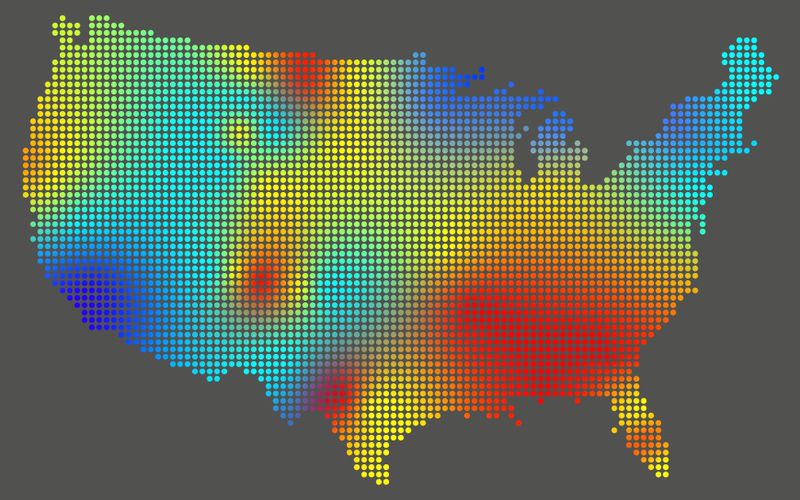

How to Read Companion Animal Parasite Council (CAPC) Maps: An Interview with Dr. Brian Herrin
The Companion Animal Parasite Council (CAPC) educates veterinary professionals and pet owners about parasites that pose a risk to pets and humans in North America by providing relevant, accurate, and timely information and resources.
These resources, which include yearly parasite prevalence forecasts, prevalence maps, and parasite guidelines, are excellent tools to help you persuade clients to screen their pets for vector-borne diseases and protect them from these dangerous parasites.
What Veterinarians Should Know: An Interview with Dr. Brian Herrin
We asked Brian Herrin, DVM, PhD, DACVM, who is CAPC secretary-treasurer and assistant professor of clinical veterinary parasitology at Kansas State University, to explain how to use and interpret the CAPC prevalence maps.
How Are Forecasting Maps Created?
"The CAPC uses historical vector-borne disease data, as well as known disease drivers, to create the forecasting maps," Dr. Herrin states. "Climatic and ecological conditions that contribute to the success of the tick, mosquito, and their reservoir hosts have been well-studied, and these variables are used to determine areas where humans and pets are at the highest risk.
In addition, the forecasts don't simply regurgitate data from city A and city B but use sophisticated algorithms to allow the data to interact. This process fills in gaps where we have no or low test results from pets and helps create the nice, smooth, gradient map that you can find on the CAPC map website."
What Factors Go Into Creating the Forecasting Maps?
"The major factor is the historic data from pets tested across the country. The data comes from clinics using IDEXX or Antech services for heartworm and tick-borne testing. Total received test numbers are now into the 10 million-plus samples every year for each disease," says Dr. Herrin.
"However, CAPC doesn't rely only on the past year's results. It includes the climatic and ecological factors that drive change and help predict next year's factors, such as annual mean temperature, annual mean precipitation, annual mean relative humidity, elevation, percent forest coverage, percent water coverage, population density, and median household income."
How Are Prevalence Maps Created?
"Serologic test results are used to create the prevalence maps, which do not contain data concerning the climate or environmental factors. New data is updated every month to ensure the information remains current."
How Should Veterinarians Interpret the Maps?
"Each forecast map includes a section in which CAPC parasitologists and clinicians highlight trends or factors veterinarians may find important or interesting," Dr. Herrin explains. "Many times, this information is regional, as a particular disease becomes more prevalent in specific areas. Suggestions range from encouraging veterinarians in endemic areas to redouble their prevention efforts to alerting veterinarians in historically lower-risk areas to anticipate increasing case numbers.
This information is especially important for practices on the outskirts of a high-risk area. These veterinarians and team members may not be as familiar with the clinical signs, diagnostic tests, or treatment plans for these diseases, and this provides a great opportunity for them to start getting educated and planning their strategy. An effective plan is essential to prevent, accurately diagnose, and treat these problematic diseases.
Overall, I think the maps should make veterinarians realize these are dynamic diseases. The vectors, reservoirs, and pathogens are on the move—and if your information dates back to your veterinary school days, you may miss out on the nuances of these diseases."
What Does This Data Mean for Veterinarians?
"Veterinarians should realize that this data may not reflect the numbers they see in their practice for many reasons. This is a great way to consider what you're doing well and what could be done better depending on where your practice falls at the region or county level.
For instance, you may see significantly fewer heartworm disease cases in your practice because your year-round heartworm prevention compliance is higher than other practices. Alternatively, you may see more heartworm disease cases in your clinic because you work with local rescue and shelter groups and treat more animals who have no preventive history.
Another important point is that this data has no attached history, and we cannot distinguish travel cases from endemic cases. Local veterinarians who gather the information can help CAPC by providing specifics about the pet's origin and travel history. Determining where the pathogens originated is crucial to continual geographic monitoring of these diseases."
What Does This Data Mean for Pet Owners?
"The maps and county-level data can be extremely useful for in-clinic discussions or client handouts. This local, timely information can be a strong incentive for pet owners to act because the specific geographic data demonstrates their pet's risk. Hearing 'X% of dogs test positive for heartworm disease in our area, and we have effective ways to protect your pet from these deadly parasites' is much more provocative for clients than hearing 'dogs get heartworm disease in the United States.'
In addition, CAPC provides map information that may be more user-friendly for pet owners," Dr. Herrin adds. "These maps help contextualize the data by regional trends and time of year, which can help pet owners better understand the changing disease risks throughout the year."
Screening for Better Care
Yearly comprehensive screening for vector-borne diseases is critical to accurately monitor the movement of these diseases across North America. Use CAPC's valuable resources to educate your clients on why screening and year-round parasite prevention are important for any and every pet.







